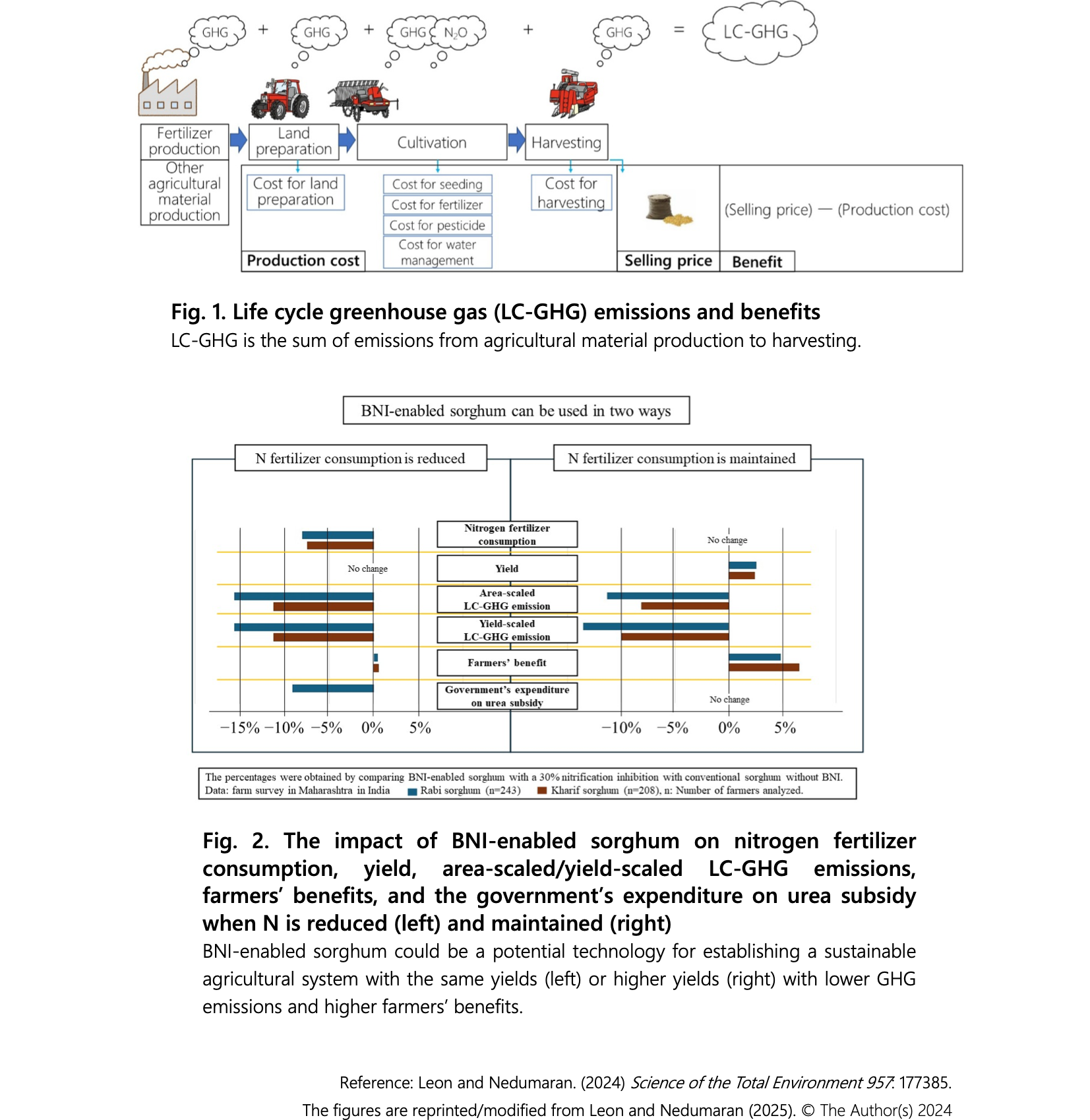BNI-enabled sorghum reduces fertilizer application in India
Description
Fertilizer consumption in India increased after the ‘Green Revolution’ and was the second highest in the world in 2018; furthermore, it has been strengthened by fertilization subsidies. Excessive subsidies, especially for urea, have distorted the balanced application of fertilizers, degraded the environment, and increased stress on national finances. Biological nitrification inhibition (BNI) from plant root systems effectively curtails nitrogen (N) loss and enhances N utilization efficiency. BNI is increasingly important as a technology for mitigating greenhouse gas (GHG) emissions and water pollution, especially in countries where N fertilizer is overdosed.
This study aims to show the potential impacts of BNI-enabled sorghum varieties with a 30% soil nitrification inhibition rate on N fertilizer use, yield, life cycle GHG (LC-GHG) emissions, farmers’ benefit, and government expenditure on subsidy under two scenarios: N fertilizer consumption is reduced (Scenario 1) or maintained (Scenario 2). We analyzed the farm survey data collected in Maharashtra, India, a major sorghum-growing state, for Rabi (in 2020–2021, n = 250) and Kharif sorghum (in 2022, n = 209). LC-GHG emissions were calculated using the life cycle assessment method (Fig.1).
Under Scenario 1 (Fig. 2, left), compared with conventional sorghum, the introduction of BNI-enabled sorghum reduced N fertilizer application in the Rabi and Kharif seasons by 8.0% and 7.4%, respectively. It also decreased area-scaled/yield-scaled LC-GHG emissions by 15.6% in the Rabi season and 11.2% in the Kharif season, while slightly increasing farmers' benefits. These changes could decrease the government's expenditure on urea fertilizer subsidies by 9.1%. However, many farmers indicated that they would not change the N fertilizer application even if the yield per N fertilizer application increased. Even under these circumstances (Scenario 2, Fig. 2, right), compared with conventional sorghum, area-scaled/yield-scaled LC-GHG emissions were decreased by 11.3% and 13.5% in the Rabi season and 8.1% and 10.2% in the Kharif season, respectively. Yield and farmers' benefits would increase by 2.5% and 4.9% in the Rabi season and by 2.4% and 6.5% in the Kharif season, respectively, but the government's expenditure on fertilizer would remain unchanged.
These results indicate that BNI-enabled sorghum can be used in two ways: reduced N fertilizer consumption (Fig. 2, left) or maintained consumption (Fig. 2, right). Some countries cannot apply enough N fertilizer to meet plant requirements, leading to low yields and exhaustion of soil fertility. BNI-enabled sorghum can be introduced in countries with low N fertilizer use to increase yield while maintaining fertilizer consumption, and in countries with high N fertilizer use to maintain yield while reducing fertilizer consumption.
Figure, table
- Research project
- Program name
- Term of research
-
FY2021-2024
- Responsible researcher
-
Leon Ai ( Social Sciences Division )
ORCID ID0000-0002-8367-4873KAKEN Researcher No.: 70751387Nedumaran Swamikannu ( International Crops Research Institute for the Semi-Arid Tropics )
- ほか
- Publication, etc.
-
Leon and Nedumaran (2024) Sci. Total Environ. 23: 177385.https://doi.org/10.1016/j.scitotenv.2024.177385
- Japanese PDF
-
2024_A05_ja.pdf987.39 KB
- English PDF
-
2024_A05_en.pdf415.34 KB
* Affiliation at the time of implementation of the study.

